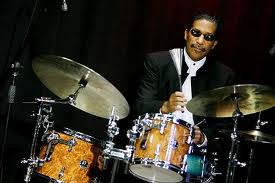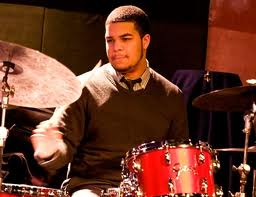Saxophonist Tim Warfield has big ideas about developing a very particular kind of jazz presenter circuit; ideas which have likely been germinating ever since he took on a producer role for the annual Central Pennsylvania Friends of Jazz festival in Harrisburg, PA, not far from his York, PA hometown. Towards that end, last June at the annual Pennsylvania Presenter Conference in Harrisburg Tim asked me to moderate a panel discussion on jazz presenting. Besides Tim the other panelists were tenor saxophonist Paul Carr, who has also taken on a festival producer role at the annual Mid-Atlantic Jazz Festival (scroll down through the Archives for the 2013 edition), and a sister named Laura Gentry who I had not met. Laura has been doing some wonderful things with jazz presenting in the areas around Cincinnati, OH, through her own LAG Productions, and our panel experience left me quite impressed with her work. In keeping with our Independent Ear month of March (Women’s History Month) series of women’s voices, some questions for Laura Gentry were in order.
What’s your background; how did you come to have such a passion for jazz?
My parents instilled in me a love for music by exposing me to every genre they enjoyed. My mother is the daughter of a musician. My maternal grandfather played guitar, banjo, and harmonica, and primarily performed blues, country, and folk music. She listened to everything: Pop, Folk, Country, Soul (now referred to as R&B) and Jazz. My father was the big jazz lover, and I heard a lot of Miles Davis, John Coltrane, Cannonball Adderley, Jimmy McGriff, Bob James, Charles Earland, and Nancy Wilson in my home while I was young. I started singing in a Baptist church when I was 5, and also sang every week at Catholic Mass at my parochial school. I sang in musical theater in high school, and continued singing in R&B cover bands during college, so I had a well rounded exposure to all music. It wasn’t until my late 20’s that I developed a better appreciation and love for jazz, and I attribute that to the foundation laid by my parents.
How did you transition that initial love for the music into LAG Productions?
I graduated from Xavier University in Cincinnati, Ohio with a degree in Accounting, but by my late 20’s I realized I needed another level of fulfillment in my life other than my career. It was as simple as asking myself “What would make me happy?”, and I knew the answer lied in getting back to something with music, preferably jazz. I started hanging out at clubs and lounges in Cincinnati that had live jazz, and just trying to meet musicians and other jazz lovers. Mutual friends introduced me to a guy who was promoting “jazz sets” in his home, and calling it The Loft Society. The Loft Society held monthly jazz sets with local, regional, and a few national artists. It was quite bohemian with folks sitting on the floor in a big loft, right at the foot of the musicians, eating, drinking, getting high, and enjoying the music. As I became friends with the owner of The Loft Society, I started assisting him in coordinating the monthly performances, executing the PR for each month, scheduling and paying the bands, collecting the cover charge at each gig, and even bringing food to feed the musicians. One of the regular players at the Loft, trumpeter Mike Wade, came to me after one gig and said, “Laura, you’re doing all the real work, why don’t you do this on your own?” And that’s when the light bulb went off in my head. My birthday is February 6th. I promoted my very first gig in February 1999. It was a birthday themed event called “Aquarius Jazz Jam”, and it was a hit. I promoted the “Aquarius Jazz Jam” annually for 5 years, expanding it each year by bringing in national acts like Rene Marie, Steve Wilson and Mulgrew Miller. That very first concert in 1999 sprouted the roots for LAG Productions.
Talk about your LAG Productions activities as they relate to jazz music.
Under LAG Productions, I’ve primarily done jazz concert promotion and venue booking, working with national artists such as Steve, Wilson, Mulgrew Miller, Rene Marie, Javon Jackson, Tim Warfield, Terell Stafford, Delfeayo and Jason Marsalis, Jeremy Pelt and Tia Fuller. I’ve promoted and booked jazz in venues in Cincinnati and Dayton, Ohio with local, regional, and national artists. I worked with the University of Cincinnati-Conservatory of Music for five years assisting with a scholarship fundraiser for the Jazz Studies Department. In 2002, I was the co-producer and festival coordinator for the Greater Cincinnati Jazz & Heritage Festival. For 13 years I’ve been the talent coordinator for the It’s Commonly Jazz concert series. Held every Thursday in August, It’s Commonly Jazz is the longest running free jazz concert series in Cincinnati, Ohio, with 2013 being our 27th year. Since 2007, I’ve been the main coordinator for the annual Col. Bill Williams Music & Heritage festival in Greenup, KY, a festival in honor of my maternal grandfather. I have been executive producer on 3 CD’s for local musicians, and been involved with artist management/consulting for several musicians, offering service for booking/road management, composing bios, and financial advice. I joined the board of non-profit organization Jazz Alive in 2008, and became president in 2010.

The ever-sassy vocalist Rene Marie has been an LAG Productions featured artist.
Which came first, LAG Productions or Jazz Alive?
Jazz Alive was founded in 2001. The three founders, Gordon Brisker, Joseph Gaudio, and Donald Carr, are all graduates of the University of Cincinnati – College Conservatory of Music (CCM). I was invited to join the board in 2008 at the request of president emeritus Don Carr (saxophone) and vice president Jim Anderson (acoustic bass), serving as Director of Media Relations and Promotions. Both Don and Jim knew me personally and professionally as a promoter, had invited me to several Jazz Alive events, and I had also donated to the organization. I was elected president of Jazz Alive in 2010.
Please tell us more about Jazz Alive and your related activities.
Jazz Alive is a 501c3 non-profit organization dedicated to the promotion and advancement of the uniquely American music art form of jazz and its practitioners. Our mission is to bring greater appreciation and understanding of jazz from bebop era to present day. Jazz Alive does this through its five areas of presentations:
1) In School Time Jazz Program – instruction and in school performances geared toward spawning the next generation of jazz enthusiasts and musicians.
2) Jazz for Seniors Program – to entertain a forgotten audience of jazz lovers in nursing homes and retirement centers.
3) Jazz concerts within the Greater Cincinnati area – encouraging a greater appreciation of jazz in our community, and preserving and expanding the heritage of jazz.
4) Jazz Alive on the Wind radio program on WMKV-FM
5) Co presenter for the It’s Commonly Jazz concert series
In 2012 Jazz Alive presented 4 concerts in Greater Cincinnati, including the CD release party for Lucky 13, the latest CD from saxophonist Javon Jackson and Les McCann. We held 7 In School Time Jazz events reaching 600 students ranging from 2nd thru 12th grades. We were the co-presenter for the 2012 It’s Commonly Jazz series, featuring national artists Wycliffe Gordon and Steve Wilson. And we presented 3 Senior Service events, providing entertainment to 100 senior citizens in nursing homes and retirement centers in Greater Cincinnati.
What’s your sense of trying to bring jazz to your part of the country?
Promoting jazz is hard because of the lack of focus it gets as part of the arts, but it’s particularly challenging in Greater Cincinnati. I had to learn the dynamics of my market, which is critical to any promoter on how to reach your core constituency and generate new patrons. Acceptable venues that are fitting for promoting jazz and ticket price also factor into how I promote and negotiate with national artists. What some artists may not realize is they cannot command the same fee in every geographical region. It may differ tremendously from the East Coast, South, and Midwest based on the mindset and cultural awareness of the market. As a promoter I strive hard to bring artists that are affordable for my market and give great performances because I feel every jazz concert should be an event that leaves a lasting impression on the listener. I like bringing in artists that I know my market has not been exposed to, whether they’re newcomers or have some tenure in the jazz world. That gives greater exposure to my patrons about musicians on the scene and for the artist to a new audience. In 1960 George Wein produced one of his first festivals in Cincinnati, The Ohio Valley Jazz Festival It morphed into the Kool Jazz Festival, but the great tradition that was established ended in the late 1970’s and early 1980’s when it changed to primarily R&B. I hope in some small way as a promoter I can contribute to the history that started with jazz in Cincinnati, and keep growing and exposing my audience into larger numbers and higher appreciation for the music.

Tenor man Javon Jackson has been featured in LAG Productions with a CD release party for his collaboration with Les McCann (shown in the collage below); this April Javon will appear in Cleveland at the annual Tri-C JazzFest (April 19-27) in residence and in tribute to Dexter Gordon.
To contact Laura Gentry: www.jazzalive.info











